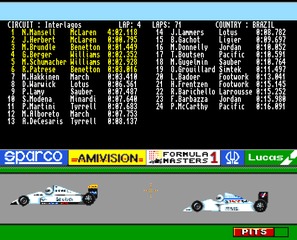
Author: GN Team - Published: 13 April 2019, 2:08 pm
Formula 1 Masters is a Formula One managerial sim created by Amivision and published by ESP Software in 1994 for the Amiga.
Today we would define it as an indie game since it was created by two people only: Stephen Rennocks (concept and programming) and Nick Stephens (graphics). The game was built in AMOS BASIC, an easy-to-use programming language designed to develop games.
Formula One Masters is a low-budget game but is an attractive sim for motor racing fans, especially the ones with some nostalgia for the Grand Prix of the '90s.
Read More
Author: GN Team - Published: 12 April 2019, 1:44 am
Center Court 2 is a tennis game created for Amiga with an AGA chipset by Gernot Fritsche in 1996-1997 but released only in 2016.
The game, written in Blitz BASIC, was supposed to be the sequel to Center Court (aka Blitz Tennis), but the Austrian coder stopped working on it when it was almost ready.
Many years later, in 2012, an English Amiga Board forum user called Python1 contacted Fritsche to ask if he had ever planned to develop a sequel to Center Court. Gernot answered: a sequel was already in development but never completed. This convinced Gernot to find his old Amiga and search for the game, but he discovered that the hard disk was severely damaged and the code was lost. Python1 didn't lose hope and searched for a solution. Gernot sent the HD to Switzerland, where Python1, working with a friend, was able to recover the data. He sent back the game code to the original author via email. At that point, there was only one thing that Gernot could do: finish the game. In 2016, Center Court 2 Tennis was finally completed and released, completely free. Great job!
Read More
Author: GN Team - Published: 11 April 2019, 1:22 am
Perihelion: The Prophecy is a cyberpunk role-playing / dungeon-crawler developed by Morbid Visions and published by Psygnosis for the Amiga in 1993.
The game was designed by Edvard Toth, who not only created the beautiful Bitmap Brothers-style graphics and artworks but also wrote the game concept and the script. He also defined the game rules, including the spell and PSI-powers system. Two other people did the rest: Zoltan Vech composed the gorgeous music, which adds a lot of atmosphere to the game, while Gyula Szentirmay coded the game.
Read More
Author: GN Team - Published: 7 April 2019, 5:21 pm
Sensible Soccer is the first game of the popular series of football sim created by Sensible Software and published by Renegade.
With this package, we are publishing the first and original release of SensiSoccer, not the v1.1 issued sometime later - also called Sensible Soccer: European Champions - 92/93 Edition.
This revolutionary game, a real milestone in the history of sports videogames, was released in 1992 for Amiga and Atari ST. Until then, Kick Off 2 was THE choice when you wanted to play football with your friends on your computer. But Sensible Soccer changed everything, creating two factions: the ones that still preferred Dino Dini's sim, and the ones that migrated to the new game created by Sensible Software.
Read More
Author: GN Team - Published: 29 March 2019, 11:34 pm
Cadaver is an isometric arcade adventure created by The Bitmap Brothers and published by Image Works in 1990 for the Amiga and Atari ST.
After the success of Xenon 2: Megablast and Speedball, the British Software house decided to try a different genre - action-adventure, but with several puzzle elements - and a different setting - fantasy. The result is an excellent game, with beautiful isometric graphics, a well designed, not linear, gameplay and, for all ZX Spectrum fans, a striking similarity with the ZX Spectrum hit Knight Lore. The game was not a commercial success but received extremely positive reviews. It won the Golden Chalice in 1990 as Adventure Game of the Year.
Read More
Author: GN Team - Published: 23 March 2019, 12:45 pm
Halo: Combat Evolved is a sci-fi first-person shooter created by Bungie Studios for Microsoft and released for the Xbox in 2001. GearBox later ported it to Windows and Macintosh in 2003.
We usually publish games at least 20 years old, but this time, we made an exception. After so many requests, since the game is currently not available on GOG or Steam, we decided to make this gift for all the fans of GamesNostalgia. You can now play Halo, one of the best games ever created. The game made the Xbox a success.
The Windows version includes Patch 1.0.10; it supports modern video cards and all kinds of screen resolutions. It works on Windows 7/10, and GameSpy support is removed (since it's no longer active). Just run the setup and install the game. That's it.
Read More